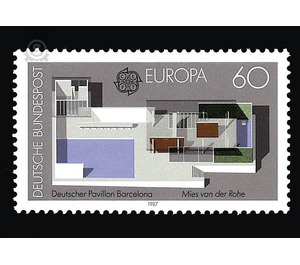Europe - Germany / Federal Republic of Germany 1987 - 60 Pfennig
Theme: Architecture
| Country | Germany / Federal Republic of Germany |
| Issue Date | 1987 |
| Face Value | 60.00 |
| Color | grey |
| Perforation | K 14 |
| Printing Type | Multicolor offset printing |
| Stamp Type | Postage stamp |
| Item Type | Stamp |
| Chronological Issue Number | 1194 |
| Chronological Chapter | GER-BRD |
| SID | 210134 |
| In 56 Wishlists | |
In the context of the XI. The European Conference of Postal and Telecommunications Administrations (CEPT) has selected the common theme "Modern Art" (with emphasis on architecture) for the 1987 European brands. Under this general theme, the Deutsche Bundespost honors two outstanding architectural achievements with the »German Pavilion Barcelona« and the »Köhlbrand Bridge Hamburg«. Mies van der Rohe's "German Pavilion at the International Exhibition Barcelona 1929" is considered a key work of modern architecture. The pavilion was a representation building, it served the self-representation of the German Reich, from which Mies van der Rohe also received the order. He did not serve a material function, such as the presentation of objects: the building itself was the object in question. However, the location of the pavilion provided access to the attractions of the International Exhibition. At the same time, its ground plan organization, which forced a multiple change of direction as it wandered through, enabled it to intensively grapple with its new architecture. The most important characteristic of this architecture is the "free floor plan", d. H. the factual and visual separation of structural and non-structural components. Thus, the roof construction is carried by steel columns, thereby the walls are freely variable, and it creates that "flowing space", that play of vertical and horizontal levels, the dynamics of "inside" and "outside", the architecture of the 20th century enriched by completely new design options. No less important for the pavilion and its aesthetic effect is the use of noble, indeed luxurious materials: walls of green tin marble rise above a huge travertine base. The building is sandwiched between two reflective basins, one of which is green, the other black glass; in the latter is the sculpture of a dancer by Georg Kolbe. Its lighting comes from a tinted frosted glass wall, and the aesthetic centerpiece is a floor-to-ceiling wall of precious onyx doré, topped with chrome-plated flat steel furniture with white leather cushions that have gained worldwide distribution as Barcalona armchairs and tables. (Text: Bauhaus Archive Berlin, Dr. Peter Hahn, Director)


